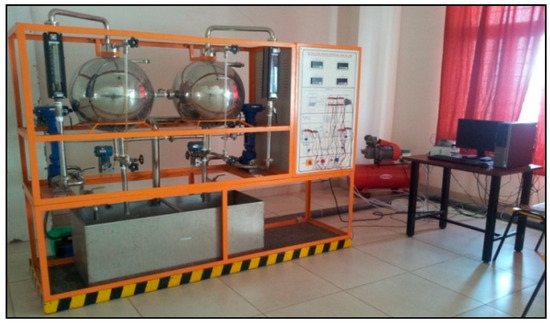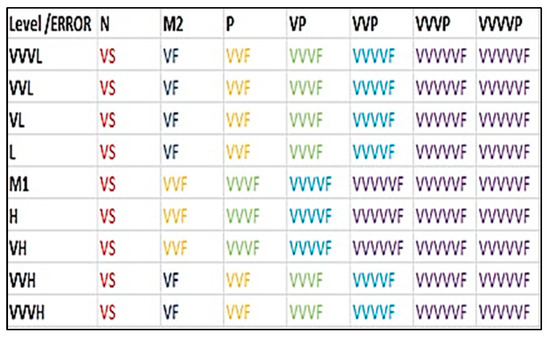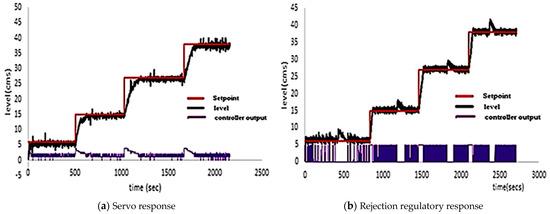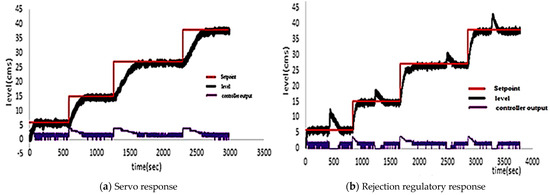Abstract
Most of the current day industries are suffering from nonlinear processes. Thus, both the stability and the process performance of high-degree nonlinear systems with dominating delay might be difficult to achieve. Adaptive and intelligent fuzzy classifiers and controllers have been more popular in recent years as a means of overcoming a significant number of difficulties faced by the industrial sector. A large number of dynamic process plants with a variety of orders and kinds have been represented heuristically and recognized. Fuzzy structures have also been employed for these interactive systems by making use of fuzzy and linguistic techniques. In view of all these initiatives, the purpose of this paper is to conduct an experimental investigation into the performance of a LabVIEW-based Type-1 Adaptive Mamdani Fuzzy Controller (AMFC) that has been designed and applied over a lag-dominant and a second-order nonlinear Dual Input Tank System (DITS) and Single Input Tank System (SITS). Compared to other type-1 approaches that were previously experimented with and are now in existence, the adaptability of AMFC demonstrates that it is quite effective. Performance indices such as the Integrated/Summated Absolute Error (IAE) and the Integrated/Summated Squared Error (ISE) are also computed for several variable set point profiles of DITS. These indices measure errors in integrated absolute value and integrated squared value, respectively. Adaptive Type-1 Intelligent Fuzzy Controller’s response and error reduction efficiency have been found for several flow configurations of DITS, namely Multiple Input Multiple Output (MIMO) and Single Input Single Output (SISO). From the results, it can be concluded that the proposed experimental validation may be used for a wide variety of process challenges that are experienced in industrial systems to achieve robust and low error controller performances.
1. Introduction
Adaptive and intelligent fuzzy classifiers and controllers have become more popular in recent years as a means of overcoming a significant number of difficulties faced by the industrial sector [1]. A large number of dynamic process plants with a variety of orders and kinds have been represented heuristically and recognized. Fuzzy structures have also been employed for these interactive systems by making use of fuzzy and linguistic techniques [2,3,4]. A linguistic description and the theory of fuzzy sets were used to implement a heuristic adaptive controller on dynamic processes. This controller was also applied to nonlinear and multi-process industrial plants to infer that they were able to control these plants in a relatively short amount of time [5]. This nonlinear self-organizing controller’s heuristics are described mathematically and may be controlled with the help of the theory of fuzzy sets [6]. They take the shape of a collection of linguistic decision rules. To illustrate a perfect nonlinear controller case study [7], an experimental testing of multiple fuzzy zones was undertaken, with the areas being high/low-gain, and large/small time-constant, respectively. This validation was based on previous information. The explanation of what enables fuzzy controllers to provide such good performance has been examined in several research efforts [8]. The dependability of these controllers has been the driving force in their widespread use across a wide variety of industrial and real-time control systems [9,10,11,12,13].
In recent years, very few attempts have also been made to improve the performance of fuzzy controllers and their precision in decisiveness by applying soft-solving techniques [14,15,16,17]. These attempts have been made in several different fields. In recent times, a great number of controllers that are capable of self-organization and adaptation have emerged to control dynamic and nonlinear systems. The swift learning and observer-independent decision-making algorithms are always refined to choose the most appropriate quick fuzzy inference rules to produce trustworthy conclusions [18,19]. Real-time temperature control, heat exchanger systems, petroleum separation processes, and effective energy management are just a few of the numerous industrial applications that have made extensive use of fuzzy PI and PD controllers. All of these applications require that critical process parameters be controlled to keep the process stable in the face of a large number of disruptions, both from the outside and from the inside. The above literature only discusses the controllers that were employed to stabilize the control variables of choice using simulations. However, this experimental investigation attempts to implement a model-less type-1 fuzzy controller for a real-time system.
Typically, plants that are complicated and unpredictable cannot be effectively addressed using traditional linear methods. Complex controllers are often necessary to provide the desired stability and robustness. However, they often lack a straightforward design approach, and their implementation might be challenging, if not unfeasible. Fuzzy logic control is an intelligent methodology that enables the conversion of logical assertions into nonlinear mapping. Despite its shown efficacy in handling intricate plant varieties, several subsequent investigations have diverged from the fundamental principle of linguistic interpretability. This study focuses on the development of a straightforward type-1 fuzzy controller, emphasizing the ease of design and the logical coherence of linguistic operators.
In the next portions of this study, we will go into further detail of the experimental procedure of DITS, as well as the theoretical modelling approaches. The findings, conclusions, and an efficiency study of their use are presented in the last section of this paper.
2. Experimental Process Description
The primary components of the laboratory setup for the chosen system are composed of two spherical tanks that interact with one another and are joined together by a valve that may be operated by hand. Both of the tanks receive water through an input and an outflow, driven by the engine, which continually draws water from the water reservoir. Both of the tanks are filled by the motor. Pneumatic valves control the amount of liquid into the storage tanks. To seal and open the pneumatic valves, a compressor, which has a position that can be altered by the application of air pressure, is used to regulate the flow used to generate pressure in the system. A few circuit systems and pieces of equipment, such as a current-to-pressure converter, a current-to-voltage converter (I-V), and a voltage-to-current converter (V-I), are all components of the integrated experimental process. In addition to this, a rotameter is provided to manually measure the flow rate in one or both of the tanks.
A differential pressure transmitter with an output current range that is typically between 4 and 20 milli-amperes is used to monitor the level that is present in the tanks. This differential pressure transmitter is connected to the personal computer via NI-DAQmx 6211 data acquisition module card, which can handle 16 analog inputs and 2 analog output channels with a voltage range between 10 Volts. The differential pressure readings are displayed on the computer. The acquisition card module has a sampling rate of 250-kilo samples per second and a resolution of 16 bits. After that, the graphical program is connected to the set-up by way of the acquisition module. LabVIEW 8.0 was used to write the application. Figure 1 and Figure 2 show, respectively, the real-time DITS experimental procedure that serves as a standard case and its interface to LabVIEW 8.0. An intelligent type-1 fuzzy controller is employed which is discussed in detail in further sections. It is a well-known fact that intelligent controllers do not require the knowledge of the model as they are model-less controllers. The detailed mathematical model of this experimental system has been derived and classical PID control techniques have also been implemented to test their efficacy [7].

Figure 1.
Real-time experimental setup of the DITS liquid level process.

Figure 2.
Interfacing computer using NI-DAQmx 6211 data card.
3. Design of Type-1 Adaptive Mamdani Fuzzy Controller
Control over the level parameter of both SITS and DITS may now be achieved using the Type-1 AMFC that has been implemented on LabVIEW. An Adaptive Mamdani Fuzzy Controller has been developed in order to meet the need for stabilizing the fluctuating degree of nonlinearity that is present in the DITS as a result of the varying diameter. The membership functions of the LabVIEW-based AMFC controller have been defined with the help of the triangle function. LabVIEW’s integrated development environment (IDE), which supports the fuzzy identification designer tool, is utilized to create the AMFC. The current level in the DITS as well as the change in error are both taken into consideration as input linguistic variables. On the other hand, the voltage applied to the valve that regulates the flow of water entering the tank is taken into consideration as an output linguistic variable.
The Mamdani approach of designing the fuzzy rules is adapted, which follows the if…and…then rules with a combination of inputs. A sample-designed rule can look like, if input 1 and input 2, then output 1. Following the same analogy, a 9 X 7 matrix of rule base has been designed, as shown in Figure 3. The rules are defined with 16 input linguistic variables, which map onto the scaled range of different outputs. Figure 4a,b show the membership functions of these variables.

Figure 3.
Rule base matrix for Mamdani-method-based AMFC controller.

Figure 4.
Membership functions of the input and output linguistic variables of AMFC.
4. Experimental Results and Discussion
LabVIEW has been used to develop AMFC, and it has been used for a real-time nonlinear DITS process. The servo response and the regulatory perturbation rejection response of AMFC have both been observed experimentally. To observe the setpoint tracking and the load rejection capabilities of the AMFC for the selected benchmark system, a varied set point profile of 6 cm, 15 cm, 27 cm, and 38 cm was applied to the DITS. This profile complied with each of the three linearized areas of the system. In the SISO mode of DITS operation, the water enters the spherical tanks by the input of Tank 1, and it leaves the process through the output of Tank 2. Similarly, the flow of water would only occur between the input and output of Tank 1 when using the SISO mode of SITS. Figure 5a,b show the servo tracking and rejection regulatory disturbance rejection performances of AMFC over SITS in the SISO mode of operation. Figure 6a,b show its performance over DITS in the SISO operation phase. At extremely close quarters, it is possible to see that the servo response of SITS has a substantially larger inaccuracy compared to that of DITS. This is something that can be observed.

Figure 5.
Servo and rejection regulatory responses of AMFC for SITS in SISO mode of operation.

Figure 6.
Servo and rejection regulatory responses of AMFC for DITS in SISO mode of operation.
Table 1 displays the values of all of the performance indices, including IAE and ISE, for all of the areas of operation, for both SITS and DITS, in both servo and regulatory modes of operation. It should be noted that the performance of Type-1 AMFC, despite the fact that it is not particularly robust, is capable of being applied, at least partially, in an industrial setting, where precision in error reduction is not a prior criterion. When used to SITS in linear areas, the error reduction is most prominently observed in Type-1 AMFC’s performance; however, when applied to DITS in regions with a larger degree of nonlinearity, it offers an error reduction in DITS. Hence, it can be deduced that Type-1 AMFC provides a lower error for systems that have a larger degree of nonlinearity and higher order and that it also provides superior performance for linear system applications.

Table 1.
Performance Values of Servo and Regulatory Responses of SITS and DITS on Application of AMFCs.
5. Conclusions
The objective of this research was to study the controller effects of Type-1 AMFC on the performance indices of SITS and DITS, which are, respectively, of the first and second orders. AMFC was shown to be more appropriate for high-degree nonlinear systems, and it also delivers a better response for linear systems. This was discovered via research. It is possible to draw the conclusion that this experimental validation may be used for a wide variety of process challenges that are experienced in industrial systems to achieve robust and low error controller performances.
Author Contributions
Conceptualization, M.K.C.; Methodology, N.V. and Y.V.P.K.; Software, C.P.R.; Formal analysis, D.J.P.; Funding acquisition, Y.V.P.K.; Investigation, M.K.C.; Resources, N.V.; Data curation, C.P.R. and D.J.P.; Supervision, N.V. and Y.V.P.K.; Validation, M.K.C.; Visualization, D.J.P.; Project administration, C.P.R.; Writing-original draft, M.K.C. and D.J.P.; Writing-review and editing, C.P.R. and Y.V.P.K. All authors have read and agreed to the published version of the manuscript.
Funding
This research received no external funding.
Institutional Review Board Statement
Not applicable.
Informed Consent Statement
Not applicable.
Data Availability Statement
All the data used are made available in the present work.
Conflicts of Interest
The authors declare no conflicts of interest.
References
- Kumar, V.B.; Rao, K.S.; Charan, G.; Pavan Kumar, Y.V. Industrial Heating Furnace Temperature Control System Design Through Fuzzy-PID Controller. In Proceedings of the 2021 IEEE International IOT, Electronics and Mechatronics Conference (IEMTRONICS), Toronto, ON, Canada, 21 April 2021; pp. 1–6. [Google Scholar] [CrossRef]
- Zhu, J.; Ma, X.; Martínez, L.; Zhan, J. A Probabilistic Linguistic Three-Way Decision Method With Regret Theory via Fuzzy c-Means Clustering Algorithm. IEEE Trans. Fuzzy Syst. 2023, 31, 2821–2835. [Google Scholar] [CrossRef]
- Rao, S.N.V.B.; Pavan Kumar, Y.V.; Amir, M.; Ahmad, F. An Adaptive Neuro-Fuzzy Control Strategy for Improved Power Quality in Multi-Microgrid Clusters. IEEE Access 2022, 10, 128007–128021. [Google Scholar] [CrossRef]
- Kumar, Y.V.P.; Rao, S.N.V.B.; Padma, K.; Reddy, C.P.; Pradeep, D.J.; Flah, A.; Kraiem, H.; Jasiński, M.; Nikolovski, S. Fuzzy Hysteresis Current Controller for Power Quality Enhancement in Renewable Energy Integrated Clusters. Sustainability 2022, 14, 4851. [Google Scholar] [CrossRef]
- Shriram, K.; Chakravarthi, M.K.; Pavan Kumar, Y.V.; Kumar, V.B.; John Pradeep, D.; Reddy, C.P. Acute decisive fuzzy haptic surface response system for tactile sensitivity. In Proceedings of the 2022 International Conference on Decision Aid Sciences and Applications (DASA), Chiangrai, Thailand, 23 March 2022; pp. 438–442. [Google Scholar] [CrossRef]
- Zahid, T.; Agha, M.H.; Warsi, S.S.; Ghafoor, U. Redefining Critical Tasks for Responsive and Resilient Scheduling-an Intelligent Fuzzy Heuristic Approach. IEEE Access 2021, 9, 145513–145521. [Google Scholar] [CrossRef]
- Chakravarthi, M.K.; Venkatesan, N. Adaptive Type-2 Fuzzy Controller for Nonlinear Delay Dominant MIMO Systems: An Experimental Paradigm in LabVIEW. Int. J. Adv. Intell. Paradig. 2018, 10, 354. [Google Scholar] [CrossRef]
- Sharma, S.; Obaid, A.J. Mathematical Modelling, Analysis and Design of Fuzzy Logic Controller for the Control of Ventilation Systems Using MATLAB Fuzzy Logic Toolbox. J. Interdiscip. Math. 2020, 23, 843–849. [Google Scholar] [CrossRef]
- Mahmoudi, S.M.; Maleki, A.; Rezaei Ochbelagh, D. Optimization of a Hybrid Energy System with/without Considering Back-up System by a New Technique Based on Fuzzy Logic Controller. Energy Convers. Manag. 2021, 229, 113723. [Google Scholar] [CrossRef]
- Hassan, T.; Abbassi, R.; Jerbi, H.; Mehmood, K.; Tahir, M.F.; Cheema, K.M.; Elavarasan, R.M.; Ali, F.; Khan, I.A. A Novel Algorithm for MPPT of an Isolated PV System Using Push Pull Converter with Fuzzy Logic Controller. Energies 2020, 13, 4007. [Google Scholar] [CrossRef]
- Al-Sakkaf, S.; Kassas, M.; Khalid, M.; Abido, M.A. An Energy Management System for Residential Autonomous DC Microgrid Using Optimized Fuzzy Logic Controller Considering Economic Dispatch. Energies 2019, 12, 1457. [Google Scholar] [CrossRef]
- Rezk, H.; Aly, M.; Al-Dhaifallah, M.; Shoyama, M. Design and Hardware Implementation of New Adaptive Fuzzy Logic-Based MPPT Control Method for Photovoltaic Applications. IEEE Access 2019, 7, 106427–106438. [Google Scholar] [CrossRef]
- Belman-Flores, J.M.; Rodríguez-Valderrama, D.A.; Ledesma, S.; García-Pabón, J.J.; Hernández, D.; Pardo-Cely, D.M. A Review on Applications of Fuzzy Logic Control for Refrigeration Systems. Appl. Sci. 2022, 12, 1302. [Google Scholar] [CrossRef]
- Chen, C.-H.; Jeng, S.-Y.; Lin, C.-J. Mobile Robot Wall-Following Control Using Fuzzy Logic Controller with Improved Differential Search and Reinforcement Learning. Mathematics 2020, 8, 1254. [Google Scholar] [CrossRef]
- Aziz, S.; Wang, H.; Liu, Y.; Peng, J.; Jiang, H. Variable Universe Fuzzy Logic-Based Hybrid LFC Control With Real-Time Implementation. IEEE Access 2019, 7, 25535–25546. [Google Scholar] [CrossRef]
- Ali, M.N.; Mahmoud, K.; Lehtonen, M.; Darwish, M.M.F. Promising MPPT Methods Combining Metaheuristic, Fuzzy-Logic and ANN Techniques for Grid-Connected Photovoltaic. Sensors 2021, 21, 1244. [Google Scholar] [CrossRef] [PubMed]
- Al Sumarmad, K.A.; Sulaiman, N.; Wahab, N.I.A.; Hizam, H. Energy Management and Voltage Control in Microgrids Using Artificial Neural Networks, PID, and Fuzzy Logic Controllers. Energies 2022, 15, 303. [Google Scholar] [CrossRef]
- Al-Mallah, M.; Ali, M.; Al-Khawaldeh, M. Obstacles Avoidance for Mobile Robot Using Type-2 Fuzzy Logic Controller. Robotics 2022, 11, 130. [Google Scholar] [CrossRef]
- Liu, Z.-H.; Nie, J.; Wei, H.-L.; Chen, L.; Li, X.-H.; Lv, M.-Y. Switched PI Control Based MRAS for Sensorless Control of PMSM Drives Using Fuzzy-Logic-Controller. IEEE Open J. Power Electron. 2022, 3, 368–381. [Google Scholar] [CrossRef]
Disclaimer/Publisher’s Note: The statements, opinions and data contained in all publications are solely those of the individual author(s) and contributor(s) and not of MDPI and/or the editor(s). MDPI and/or the editor(s) disclaim responsibility for any injury to people or property resulting from any ideas, methods, instructions or products referred to in the content. |
© 2023 by the authors. Licensee MDPI, Basel, Switzerland. This article is an open access article distributed under the terms and conditions of the Creative Commons Attribution (CC BY) license (https://creativecommons.org/licenses/by/4.0/).